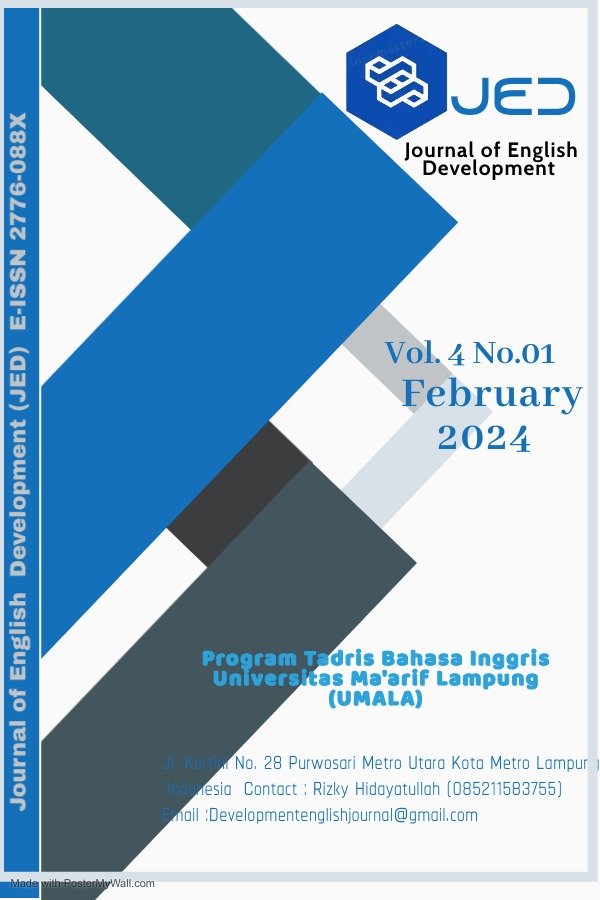The Use of Social Networking Site to Increase Students’ Reading Achievement of State Junior High School 3 Of Rambang Niru
English
DOI:
https://doi.org/10.25217/jed.v4i01.4351Keywords:
English, Reading, Learning MediaAbstract
This study aims to describe how social networking site could improve students’ reading achievement of State Junior High School 3 of Rambang Niru. This research used the Classroom Action Research (CAR) which consists of four steps, namely planning, action, observation and reflection. Success Criteria of the Reasearch is the school minimal passing grade, which was 60. The result of this study is Social Networking Site can improve the students’ reading achievement of the eight gare students as Junior High School 3 of Rambang Niru. It could be seen in the result of cycle III. There were 28 students who had met English standard score was 60, it was around 87.5% and the mean students was 75.62. It is possible to draw the conclusion that social networking sites are highly beneficial and have a significant impact on raising students' reading achievement based on the findings in the previous chapter. Students can use social networking sites (SNS) to learn English outside of the classroom at any time and from any location, regardless of time or space constraints. Students utilized social networking sites (SNS) for studying, particularly English, as it was effective and adaptable.
References
Ambarsari, Z. (2020). Penggunaan Instagram Sebagai Media Pembelajaran. Prosiding Seminar Nasional PBSI-III Tahun 2020, 81–86.
Afrizal, M. (2015). A Classroom Action Research: Improving Speaking Skills Through Information Gap Activities. English Education Journal (Eej), 6(3), 342–355.
APJII. (2021). Buletin APJII Edisi 94-September 2021. Apjii, September, 2.
Behlol. (2015). Concep of Learning. International Journal of Psychological Studies, 2.
Boyd, D. M., & Ellison, N. B. (2007). JCMCIntro. 1–23. papers2://publication/uuid/63E27A13-3AFA-4DFD-A37C-1C63A318A63F
Chartrand, R. (2012). Social networking for language learners: Creating meaningful output with Web 2.0 tools. Knowledge Management and E-Learning, 4(1), 97–101. https://doi.org/10.34105/j.kmel.2012.04.009
Dutta, S. (2020). The Importance of “English” Language in Today’S World. International Journal of English Learning & Teaching Skills, 2(1), 1028–1035. https://doi.org/10.15864/ijelts.2119
Fatwa, A. (2021). Pemanfaatan Teknologi Pendidikan Di Era New Normal. Jurnal Mahasiswa Teknologi Pendidikan, 1(2), 0–216.
Frankael. (2011). How to Design and Evaluate Research in Education.
Ghazali. (2020). Learners’ Perception on Using Social Networking Site to Reinforce Their Lingustic Performance. Journal of Language and Linguistic Studies, 16.
Gladys. (2021). persepsi mahasiswa terhadap pengaruh penggunaan instagram dalam pembelajaran bahasa inggris.
Ghory, M. Djuanaidi (2008), Penelitian Tindakan Kelas, Malang: UIN Malang press, p. 8
Hermansyah. (2018). Pengaruh Strategi Writing in the Here and Now Terhadap Kemampuan Menulis Argumentasi Siswa Kelas X SMK Madyatama Palembang. Wahana Didaktika, 16.
Jakpat.com. (2021). Indonesia Social Media Trend 1 Semester of 2021.
Kaplan, A. M., & Haenlein, M. (2010). Users of the world, unite! The challenges and opportunities of Social Media. Business Horizons, 53(1), 59–68. https://doi.org/10.1016/j.bushor.2009.09.003
Koskimma. R (2007). The challenge of cybertext teaching literature in the digital world. University of Jyväskylä. Retrieved from http://uocpapers.uoc.edu.
Marsevani, M., & Habeebanisya. (2022). A Classroom Action Research: Improving Speaking Skills Through Work in Pairs Technique. E. TLEMC (Teaching and Learning English in Multicultural Contexts), 6(1), 16–22. http://jurnal.unsil.ac.id/index.php/tlemc/index
Meilinda, N. (2018). Social Media on Campus : The Journal of Society & Media, 2(1), 53–64.
Mizanie, D., & Irwansyah, I. (2019). Penggunaan Social Network Site (SNS) Instagram Sebagai Media Pemasaran Geriliya Digital. Jurnal Komunikasi, 10(2), 89–98. https://doi.org/10.31294/jkom.v10i2.5655
Norhailawati, M., Handayani, L., Kalsum, H. U., Saringat, Z., Aidahani, A., Bakri, S. H., & Prahmana, R. C. I. (2019). The power of social networking sites: Student involvement toward education. International Journal of Evaluation and Research in Education, 8(3), 549–556. https://doi.org/10.11591/ijere.v8i3.20352
Rianto, D., & Farid, M. M. (2016). Penggunaan Jejaring Sosial Dalam Mendukung Jaringan Antar Perguruan Tinggi. Kntia, 7–12. http://www.seminar.ilkom.unsri.ac.id/index.php/kntia/article/view/709
Rodandy. (2012). Management Public Relation dan Media Komunikasi.
Rusdi, S. Y. (2015). Improving The Students Speaking Ability By Using Thematic Materials (A Classroom Action Research To The First Year Students Of Mtsn. Model Makassar). Eternal (English, Teaching, Learning, and Research Journal), I(02), 257–269.
Sanjaya,Wina (2013), Penelitian Tindak Kelas, Jakarta: Kencana, p.25
Srinivasacharlu, A. (2020). Using Youtube in Colleges of Education. Shanlax International Journal of Education, 8(2), 21–24. https://doi.org/10.34293/education.v8i2.1736
Statista.com. (2021). Active social media user Indonesia.
Suwandi, Penelitian Tindakan Kelas, Surakarta, Indonesia: Panitia Sertifikasi Guru, Universitas Negeri Sebelas Maret, 2007
Sudijono, Anas . (2014), Pengantar Statistik Pendidikan, Jakarta: Raja Grafindo Persada, p. 86.
Sugiyono. (2012). Metode Penelitian Kuantitatif Kualitatif, dan R and D.Uzer, Y. V. (2018). Teaching Listening By Using Infomation Transfor Diagram Activity to the Seven Grade Student of the State Junior Hight School 43 of Palembang. ELTE Journal, 45.
Yunarso. (2015). Implementasi Aplikasi Jejaring Sosial Alat Bantu Pembelajaran Bahasa Inggris. Infotel, 7.

Downloads
Published
How to Cite
Issue
Section
License
Copyright (c) 2024 Repika Claudia Saputri, Mulyadi, Hanni Yukamana

This work is licensed under a Creative Commons Attribution-ShareAlike 4.0 International License.





